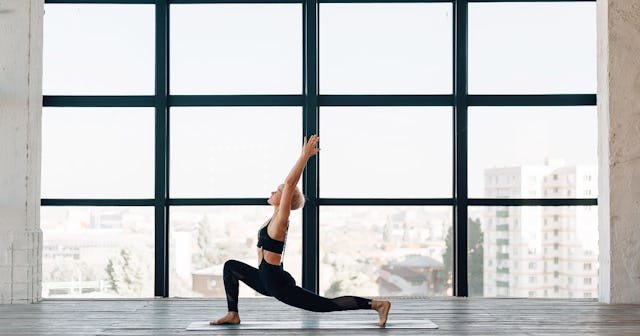What Is Yoga Good For? What It Can Do For You, From Stress Relief To Better Sex

By now, we all know yoga is good for us. Yoga has transformed from a practice only hippies and Madonna did to a mainstream fitness phenomenon. Scroll through any social media feed, and you’re bound to see yogis of all shapes and sizes bending and twisting their bodies into pretzel-like yoga positions (all with a smile on their face, no less). But what are the benefits of yoga? Exactly what are all those crazy headstands and child’s poses doing for your body — other than giving you the mighty strength of Serena Williams and the flexibility of a newborn?
Well, first, it’s vital to point out that yoga isn’t just a physical exercise. In fact, it’s more so a meditation than anything. In Sanskrit, yoga means “union,” an ancient practice that brings together mind and body. With that in mind, it’s little wonder that practicing yoga is not only good for your bod but also a fantastic discipline that helps promote mental wellness and health.
So, if you’re looking for more reasons to hit the mat and try out your best downward dog, here are some pretty tremendous benefits of yoga to consider.
What are the benefits of yoga?
Giphy
1. It reduces stress.
Stress is something we’re always going to live with, but how we manage it can help reduce it. Enter, yoga. A number of studies have shown that regularly practicing yoga can decrease the secretion of cortisol, the primary stress hormone.
2. It can enhance your sex life.
To state the obvious, becoming a yogi may mean your body will be able to bend itself in all sorts of new ways that can inject a sense of fun and flexibility into your lovemaking. In general, though, yoga can enhance your sex life overall. One study found that women who engaged in a 12-week yoga program reported better sexual function in all six stages: desire, arousal, lubrication, orgasm, satisfaction, and pain. By connecting body with breath, you’re bound to have better orgasms. And because it releases tension, you’re more likely to be less inhibited and more engaged in the bedroom. You may even feel inspired to try some new and exciting sex positions. As they say, namaste… in bed!
3. You’ll sleep better.
Having trouble sleeping at night? Instead of warming that cup of milk, consider yoga, which is known to promote better sleep. Yoga alleviates your stress and anxiety — common factors to sleep problems — allowing you to catch those ZZZs.
4. Improves flexibility and balance.
Talk about a no-brainer, right? With all those standing poses and forward bends, your body’s flexibility and balance are bound to improve. Maintaining those qualities is particularly essential for seniors, so try to convince Mom to join you! Even practicing 15 to 30 minutes a day is known to increase your flexibility and balance significantly.
5. Can help improve your breathing.
Yoga uses deep breathing called Pranayama that focuses on controlling the breath through breathing exercises and techniques. This technique can help build endurance, optimize performance, and keep your lungs and heart healthy — particularly for those who might have lung disease, heart problems, and asthma.
6. It might help relieve your migraines.
Suffering from migraines can be killer. Luckily, doing some yoga might offer you some relief. A study that used yoga therapy for three months found reductions in headache intensity, frequency, and pain. Why? Yoga stimulates the vagus nerve, which has been shown to be effective in relieving migraines.
7. You can get super strong.
Remember Madonna’s biceps in the ’90s? Or Christy Turlington’s long and lean physique? That was all yoga, baby. Specific poses help build strength and endurance, resulting in super-strong — and super-toned — muscles. Studies show that regular yoga practice can significantly increase upper body strength, endurance, and overall fitness.
8. It could reduce chronic pain.
One of the most significant benefits of yoga is its potential to help reduce chronic pain. Whether you have arthritis or a sore wrist from typing all day at the computer, growing research has shown that yoga can help alleviate chronic pain, including from conditions such as carpal tunnel syndrome and osteoarthritis.
How many days a week should I do yoga?
Like most forms of exercise, you can merge yoga into your weekly schedule. However, you don’t have to worry about doing it every day (unless you want to!). Two to three times a week is a great start, as long as you’re consistent. If you can find the time, doing yoga each day can increase the amazing benefits mentioned above.
Does yoga change your body shape?
It depends on the type of yoga you do. If you are looking to alter your body, the key is to make your yoga exercises more active and rigorous. Hot yoga and challenging poses can help you work up a sweat, which can lead to trimming and toning. Yoga can also help you strengthen your muscles.
When should you not do yoga?
Yoga is a great practice to incorporate into your day-to-day, but like any form of exercise, it’s important to know when to take a break. Here are a few signs you should roll up your yoga mat for a bit.
- If you’re feeling sick, are extremely tired, or in a hurry, you won’t get the full benefits out of your yoga session.
- If your period is especially painful, the different poses may add to your discomfort. In that case, it may be better to wait a few days after your period has started.
- Yoga practitioners recommend allowing your body at least 30 minutes to process food before stepping onto your mat.
This article was originally published on